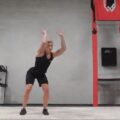Introduction to the Seated Dumbbell Shoulder Press
The seated dumbbell shoulder press is a fantastic exercise for building strong, sculpted shoulders and upper body strength. But beyond just the physical benefits, this movement can be a powerful tool for cultivating mindfulness, body awareness, and self-compassion. In this article, we’ll explore how to master the seated dumbbell shoulder press with a focus on overall wellbeing rather than just physical gains.
The Mind-Body Connection in Shoulder Presses
As you settle into your seat and prepare for the shoulder press, take a moment to center yourself. Feel the weight of the dumbbells in your hands and your connection to the ground beneath you. This exercise isn’t just about moving weight – it’s an opportunity to tune into your body and cultivate presence.
With each rep, focus on your breath. Inhale as you lower the weights, and exhale powerfully as you press up. This breath-movement coordination not only helps with proper form, but it anchors you in the present moment. Notice the sensations in your muscles, the stability of your core, the strength in your shoulders.
Proper Form: A Practice in Self-Care
Maintaining proper form during the seated dumbbell shoulder press isn’t just about maximizing gains – it’s an act of self-care and respect for your body. Here’s how to do it with compassion:
- Sit tall with your feet flat on the floor, engaging your core for stability.
- Hold the dumbbells at shoulder level, with your palms facing forward.
- As you press the weights overhead, move slowly and with control.
- Fully extend your arms at the top, but avoid locking your elbows.
- Lower the weights back down to shoulder level with the same mindful control.
Remember, it’s not about how much weight you can lift, but how well you can perform the movement. Listen to your body and choose a weight that allows you to maintain good form throughout your set.
Embracing Challenge with Self-Compassion
The shoulder press can be challenging, especially as you progress to heavier weights or higher reps. Instead of getting frustrated or self-critical when things get tough, approach the challenge with self-compassion. Acknowledge that growth often involves discomfort, and be proud of yourself for showing up and putting in the effort.
If you need to take a break or lower the weight, do so without judgment. Every workout is a journey, and setbacks are a natural part of progress. Treat yourself with the same kindness you would offer a friend who’s working hard towards their goals.
Variations to Suit Your Needs
The beauty of the seated dumbbell shoulder press is its versatility. There are many variations to explore, allowing you to adapt the exercise to your current needs and abilities:
- Alternating Arms: Press one arm at a time for an added core challenge and to address any strength imbalances.
- Arnold Press: Start with palms facing you, then rotate as you press up for a greater range of motion.
- Single-Arm Press: Focus on one side at a time to improve stability and mind-muscle connection.
- Tempo Variations: Slow down the movement, especially on the lowering phase, to increase time under tension.
Remember, the “best” variation is the one that feels right for your body on any given day. Don’t be afraid to experiment and find what works best for you.
Integrating Shoulder Presses into a Balanced Routine
While the seated dumbbell shoulder press is an excellent exercise, it’s important to incorporate it into a well-rounded fitness routine. Balance is key to overall wellbeing, both in your workouts and in life. Consider pairing shoulder presses with complementary exercises like rows for back strength, or gentle yoga to improve flexibility and mindfulness.
Listen to your body and give yourself adequate rest between shoulder-intensive workouts. Recovery is just as important as the exercise itself – it’s during rest that your muscles repair and grow stronger. Use this downtime to practice other forms of self-care, whether that’s meditation, reading, or spending time in nature.
FAQ: Mastering the Seated Dumbbell Shoulder Press
1. How often should I do seated dumbbell shoulder presses?
The frequency depends on your overall routine and goals, but 1-2 times per week is often suitable for most people. Always listen to your body and allow for adequate recovery between sessions.
2. What if I can’t lift the dumbbells all the way overhead?
It’s okay to start with a partial range of motion and gradually work your way up. Focus on maintaining good form with the range you can manage, and over time, you’ll likely see improvements in your mobility and strength.
3. Are seated shoulder presses better than standing ones?
Neither is inherently “better” – they each have their benefits. Seated presses can help isolate the shoulders more, while standing presses engage more core and overall body stability. Choose the version that aligns with your goals and feels best for your body.
4. How can I make sure I’m not using momentum to lift the weights?
Focus on controlled movements and avoid swinging or using your legs to drive the press. Start with a weight you can manage with good form, and consider using a slower tempo to really feel the muscle engagement.
5. What should I do if I experience shoulder pain during the exercise?
Stop the exercise if you feel pain. It’s important to differentiate between the discomfort of exertion and actual pain. If pain persists, consult with a fitness professional or healthcare provider to assess your form and ensure you’re not risking injury.
Conclusion: Strength Beyond the Physical
Mastering the seated dumbbell shoulder press is about more than just building strong deltoids. It’s an opportunity to practice mindfulness, cultivate body awareness, and approach your fitness journey with compassion and self-care. Remember, true strength encompasses both the physical and the mental – by focusing on both aspects, you’ll not only see improvements in your shoulder press, but in your overall wellbeing.
As you continue your practice, celebrate your progress, be patient with yourself, and always prioritize how you feel over how much you can lift. The real mastery lies not in perfection, but in showing up consistently and treating yourself with kindness along the way.









